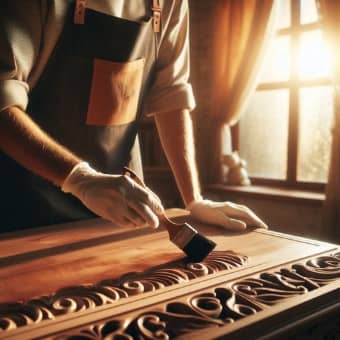Choosing the Perfect Finish for Your Woodworking Project
A Guide to Stains, Paints, and More
Understanding Your Project’s Needs
Before diving into specific finishes, it’s crucial to understand what your project will be used for. Here are some key questions to ask yourself:
Function: What will the finished piece be used for? A high-traffic coffee table needs a more durable finish than a decorative wall hanging.
Location: Will the piece be indoors or outdoors? Outdoor furniture needs a weather-resistant finish, while indoor pieces have more flexibility.
Wood Type: Different woods have different characteristics that affect how they accept finishes. For example, hardwoods are generally denser and take stains differently than softwoods.
Desired Aesthetic: Are you aiming for a natural look that highlights the wood grain, or a painted finish for a pop of color?
This web page contains affiliate links. When you click on a link on this page and make a purchase, I may earn a small commission, at no additional cost to you. Thank you for your support.
The Three Main Finish Categories
Once you have a handle on your project’s needs, you can explore the three main finish categories:
Film-forming finishes: These create a protective layer on the wood’s surface. Popular options include polyurethane, varnish, lacquer, and shellac. They offer excellent durability and come in various sheen levels, from high gloss to matte. These are ideal for high-traffic pieces like coffee tables, kitchen cabinets, or dressers that need frequent cleaning.
Penetrating finishes: These soak into the wood, enhancing the grain while providing some protection. Common choices include tung oil, linseed oil, Danish oil, and waxes. They offer a natural look and are generally easier to repair than film-forming finishes. These are perfect for highlighting the natural beauty of wood on pieces like cutting boards (with food-safe oil!), side tables, or bedroom furniture.
Paint: Paint provides complete color coverage and comes in endless possibilities. Latex and oil-based paints are the most common types, each with its own advantages. Latex paint dries quickly, cleans up with water, and is less odorous, while oil-based paint offers superior durability and a smoother finish. Painted finishes are ideal for a complete color change or hiding imperfections on cabinets, bookshelves, or children’s toys.

Stains: Adding Color and Dimension
Stains are often used in conjunction with a clear finish to add color or highlight the wood grain. They come in various application methods (brush, rag, spray) and can be transparent, semi-transparent, or solid-colored. You can use a dark stain to accentuate the grain of a hardwood table or a light stain to brighten a softwood bookshelf.
Matching the Finish to the Wood
Different wood species react differently to finishes. Here are some general tips:
Hardwoods: These tend to take stains more evenly and benefit from a wider range of finish options, including oil or water-based polyurethane, lacquer, or varnish.
Softwoods: Due to their open grain, softwoods may absorb stain unevenly. Consider a pre-stain conditioner to achieve a more uniform finish. Softwoods also benefit from penetrating finishes like tung oil or wax to enhance the natural grain.
Ted’s Woodworking: A Treasure Trove of Project Inspiration
Now that you’re armed with this finishing knowledge, you’re ready to take on your next woodworking project! If you’re looking for inspiration and detailed plans to guide you, look no further than Ted’s Woodworking.
With a vast collection of woodworking plans for all skill levels, Ted’s Woodworking has something for everyone. Explore their library and find the perfect project to showcase your newfound finishing skills!
Safety Considerations When Working with Finishes
Woodworking finishes can contain volatile organic compounds (VOCs) that can irritate the lungs and skin. Here are some safety tips to keep in mind:
Always work in a well-ventilated area. Open windows and doors, or use a fan to create airflow.
Wear safety gear. Use gloves, safety glasses, and a respirator when applying finishes, especially when spraying.
Follow the manufacturer’s instructions for application and drying times.
Dispose of rags and other finishing materials properly. Let them dry completely before throwing them away to avoid spontaneous combustion.
**Remember, choosing the perfect finish is about finding the balance between aesthetics, protection, and ease of use. With a little planning
